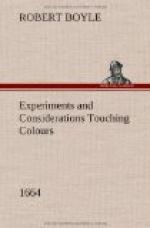shall shew anon to be Producible, barely by such another
change in Black Horn? and yet this so easily acquir’d
Whiteness seems to be as truly its Colour as the Blackness
was before, and at least is more Permanent than the
Greenness of Leaves, the Redness of Roses, and, in
short, than the Genuine Colours of the most part of
Nature’s Productions. It may indeed be
further Objected, that according as the Sun or other
Luminous Body changes place, these Emphatical Colours
alter or vanish. But not to repeat what I have
just now said, I shall add, that if a piece of Cloath
in a Drapers Shop (in such the Light being seldome
Primary) be variously Folded, it will appear of differing
Colours, as the Parts happen to be more Illuminated
or more Shaded, and if you stretch it Flat, it will
commonly exhibit some one Uniform Colour, and yet these
are not wont to be reputed Emphatical, so that the
Difference seems to be chiefly this, that in the Case
of the Rain-bow, and the like, the Position of the
Luminary Varies the Colour, and in the Cloath I have
been mentioning, the Position of the Object does it.
Nor am I forward to allow that in all Cases the Apparition
of Emphatical Colours requires a Determinate position
of the Eye, for if Men will have the Whiteness of
Froth Emphatical, you know what we have already Inferr’d
from thence. Besides, the Sun-beams trajected
through a Triangular Glass, after the manner lately
mention’d, will, upon the Body that Terminates
them, Paint a Rain-bow, that may be seen whether the
Eye be plac’d on the Right Hand of it or the
Left, or Above or Beneath it, or Before or Behind
it; and though there may appear some Little Variation
in the Colours of the Rain-bow, beheld from Differing
parts of the Room, yet such a Diversity may be also
observ’d by an Attentive Eye in Real Colours,
look’d upon under the like Circumstances, Nor
will it follow, that because there remains no Footsteps
of the Colour upon the Object, when the Prism is Remov’d,
that therefore the Colour was not Real, since the
Light was truly Modify’d by the Refraction and
Reflection it Suffer’d in its Trajection through
the Prism; and the Object in our case serv’d
for a Specular Body, to Reflect that Colour to the
Eye. And that you may not be Startled, Pyrophilus,
that I should Venture to say, that a Rough and Coiour’d
Object may serve for a Speculum to Reflect the
Artificial Rain-bow I have been mentioning, consider
what usually happens in Darkned Rooms, where a Wall,
or other Body conveniently Situated within, may so
Reflect the Colours of Bodies, without the Room, that
they may very clearly be Discern’d and Distinguish’d,
and yet ’tis taken for granted, that the Colours
seen in a Darkned Room, though they leave no Traces
of themselves upon the Wall or Body that Receives
them, are the True Colours of the External Objects,
together with which the Colours of the Images are Mov’d
or do Rest. And the Errour is not in the Eye,
whose Office is only to perceive the Appearances of




